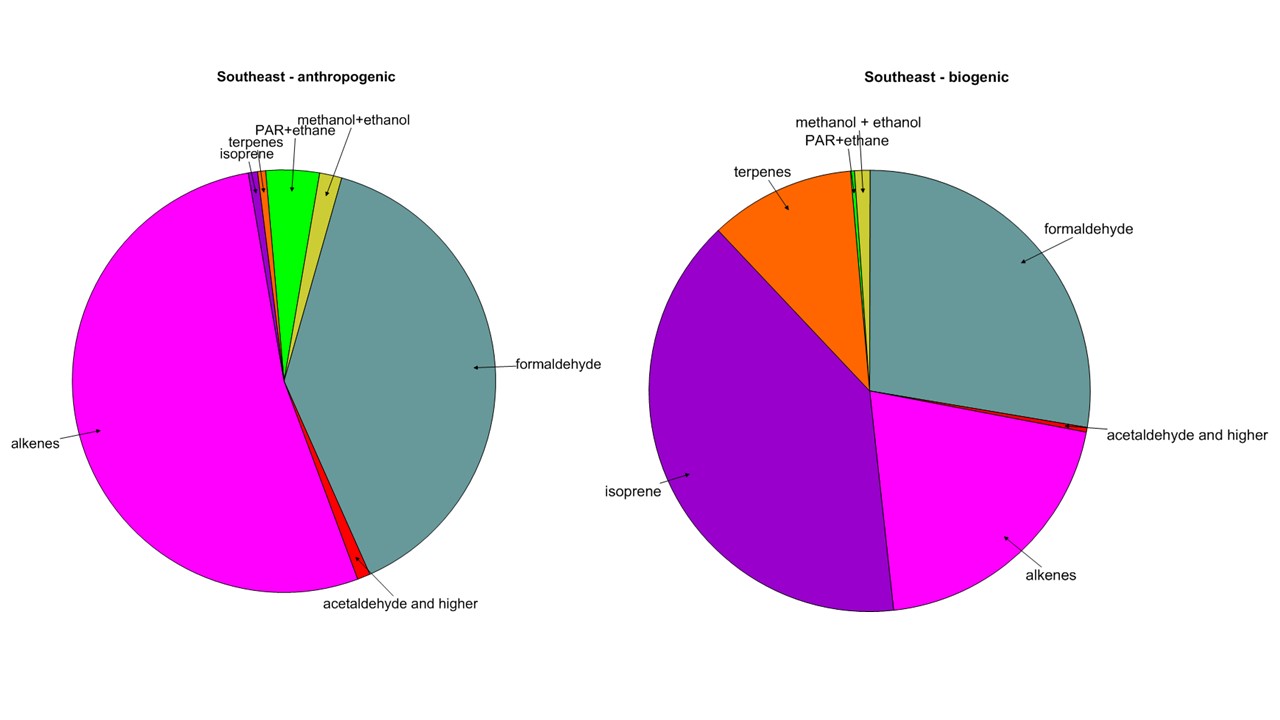Modeling Toxic Air Pollutants - CMAQ
The CMAQ modeling system can predict the concentration and deposition of many Hazardous Air Pollutants (HAPs), also known as air toxics. These are speciesAn individual molecule or chemical compound. which are known or suspected to cause cancer, neurological disorders, immune system damage, and other serious health effects. Several are among the 188 air toxics listed in the Clean Air Act. Other organic and inorganic compounds outside this list are potentially hazardous and CMAQ can be updated to include new pollutants as additional research identifies them. EPA’s HAPs website provides more information on specific HAPs and EPA’s important role in managing community exposure to them.
The CMAQ model can simulate HAPs in the gas and particle phases while simulating criteria pollutants. Standard CMAQ simulations typically used to estimate ozone and fine particles include only a few HAPs. In studies focused on determining and assessing the health effects of HAPs, CMAQ can be used to model additional HAPs by a simple modification in how the model is compiled and executed. This HAPs version of CMAQ does not alter predictions for ozone and other criteria pollutants compared to standard CMAQ simulations. Currently, 41 different gas-phase HAPs can be predicted in CMAQ, as listed in Table 1. Some of them are represented by more than one model output to unravel how photochemical production versus emissions contribute to predictions for formaldehyde, acetaldehyde and acrolein. CMAQ also represents 16 different aerosol phase HAPs, as listed in Table 2. Most are represented in three aerosol modes: Aitken (diameter less than 0.1 μm), accumulation mode (diameter greater than 0.1 μm and less than 2.5 less μm) and coarse mode (diameter greater than 2.5 μm and less than 10 μm). The Aitken and accumulation modes are also referred to as fine modes.
|
HAP Name |
HAP Name |
|---|---|
|
acetaldehyde - total and emitted |
formaldehyde - total and emitted |
|
acetonitrile |
hexamethylene 1-6-diisocyanate |
|
acrolein - total and emitted |
n-hexane |
|
acrylic acid |
hydrazine |
|
acrylonitrile (propenenitrile) |
hydrochloric acid |
|
benzene |
mercury - elemental and gas |
| benzo(a)pyrene | methanol |
|
1,3-butadiene |
methyl chloride |
|
carbon tetrachloride |
maleic anhydride |
|
carbonyl sulfide |
naphthalene |
|
chlorine |
quinoline |
|
chloroethene (vinyl chloride) |
styrene (ethenylbenzene) |
|
chloroform |
1,1,2,2-tetrachloroethane |
|
chloroprene |
tetrachloroethylene (perchloroethylene) |
|
1,2-dibromoethane |
toluene |
|
p-dichlorobenzene |
2,4-toluene diisocyanate |
|
1,2-dichloroethane |
trichloroethylene |
|
dichloromethane |
triethylamine |
|
1,2-dichloropropane |
xylene - sum of o-, m- and p- isomers |
|
1,3-dichloropropene |
|
|
ethylbenzene |
|
|
ethylene oxide |
|
HAP name |
|---|
|
arsenic - fine and coarse modes |
| benzo(a)pyrene - fine modes |
|
beryllium - fine and coarse modes |
|
cadmium - fine and coarse modes |
|
chromium 3 - fine and coarse modes |
|
chromium 6 - fine and coarse modes |
|
diesel PM elemental carbon - fine modes |
|
diesel PM organic carbon - fine modes |
|
diesel PM sulfate - accumulation mode |
|
diesel PM nitrate - accumulation mode |
|
diesel PM other components - fine modes |
|
diesel PM - coarse mode |
|
lead - fine and coarse modes |
|
manganese - fin and coarse modes |
|
mercury - fine and coarse modes |
|
nickel - fine and coarse modes |
The HAPs simulated by CMAQ were chosen because they pose significant human health risks in urban areas and over regional areas. In addition to HAPs listed in Table 1, CMAQ can be modified to model other potential HAPs for research studies. For example, versions of CMAQ have previously been developed to model toxic compounds such as herbicides (atrazine) and hydrofluorocarbons (tetrafluoropropene).
Uses of CMAQ for HAPs
An important use of CMAQ with HAPs is predicting concentrations and deposition for EPA’s Air Toxics Screening Assessment (AirToxScreen). Previous assessments have identified acrolein, formaldehyde and benzene as national or regional health risk drivers. Using CMAQ for the AirToxScreen has an extra benefit HAPs can be estimated where monitoring equipment does not exist.
Understanding the sources of the HAPs is critical towards creating strategies to lower their concentrations. For example, Figure 1 shows the photochemical sources of ambient formaldehyde over a simulation for July, 2014. Most ambient formaldehyde is from organic compounds other than formaldehyde, so understanding atmospheric chemistry is important for determining how to reduce harmful levels of formaldehyde and many other HAPs.
CMAQ for HAPs allows the users to take advantage of the predictions of both criteria and hazardous pollutants within a single simulation to determine how emission control strategies affect criteria air pollutants (CAPs) and HAPs differently. This can be used to answer critical questions such as:
- What emission control strategies optimize human and ecological health regarding both short term (i.e. respiratory, cardiopulmonary) and long term risks (i.e. cancer)?
- Do the strategies developed use the best understanding of the processes that affect both CAPs and HAPs?
- Do control strategies improve air quality for one pollutant but cause other pollutants to increase?
- What atmospheric processes dominate the interconnections between specific pollutants?
- How can we respond rapidly to emerging issues regarding both CAPs and HAPs, such as new emission sources and meteorological conditions?
In addition to the above applications, future efforts involve extending the CMAQ model to address issues such as the use of biofuels and emissions of new compounds. This might include adding compounds that are precursors to HAPs or new compounds that also impact human and environmental health.

